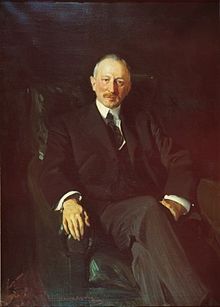17:
138:
where he established his headquarters and received his most important clients. After a dispute with his brother Arnold, there was a split in the company: Arnold continued to manage the Place Vendôme site as Arnold
Seligmann & Cie. while Seligmann consolidated his activities at the Hôtel de Monaco
151:'s renowned collection which contained a variety of valuable antiques and art works. In 1920, his son Germain Seligman became a partner and president of the New York office, formally joining Jacques Seligmann & Fils. Seligmann died in Paris in October 1923.
102:
Initially
Seligmann dealt mainly in antiques including enamels, ivories, sculptures, tapestries and especially 18th century French furniture but paintings became increasingly important at the beginning of the 20th century. After the end of the
59:, Seligmann moved to Paris in 1874 where he worked for Paul Chevallier, an auctioneer, and Charles Mannheim, an art expert, before opening his own business on the Rue des Mathurins in 1880 with
304:
299:
289:
240:
Seligman, Germain: "Merchants of art: 1880-1960; eighty years of professional collecting", New York, Appleton-Century-Crofts, 1962, 294 pages.
47:
with businesses in both Paris and New York. He was one of the first to foster
American interest in building collections of European art.
147:
and incorporated his company in the State of New York. The same year, while in Paris, he was successful in buying a large part of
124:
264:
64:
220:
259:
274:
294:
269:
71:. Seligman opened a New York office in 1904, visiting it once a year. His customers included members of the Russian
161:
16:
243:
Seligmann, Jacques: "Pour sauver notre marché des objets d'art", 2e partie, Paris, Imprimerie de l'art, 1921
204:
84:
63:
as one of his early clients. In 1900, together with his brothers Arnold and Simon, he established the firm
128:
56:
140:
135:
284:
279:
60:
148:
116:
76:
21:
174:
112:
108:
68:
177:, was born in Paris on 25 February 1893. His mother's maiden name was Blanche Falkenberg.
80:
221:"Scott Collection Deal.; Jacques Seligmann Says He Plans to Sell Each Object Separately"
96:
253:
120:
92:
144:
88:
104:
40:
107:, interest in European art grew in the United States led by socialites such as
72:
44:
32:
143:. In 1914, Seligmann opened a new office and gallery on New York's
36:
15:
205:"Jacques Seligmann & Co. records, 1904-1978, bulk 1913-1974"
8:
139:and, in 1912, opened a new Paris office at
305:Emigrants from the German Empire to France
134:In 1909, Seligmann bought the prestigious
227:, May 27, 1914. Retrieved 16 July 2011.
186:
200:
198:
196:
194:
192:
190:
75:, the high-flying British politician
7:
14:
67:which moved the same year to the
79:and American collectors such as
300:French male non-fiction writers
20:Jacques Seligmann, portrait by
1:
290:Businesspeople from Frankfurt
65:Jacques Seligmann & Cie.
321:
162:Metropolitan Museum of Art
39:) was a highly successful
211:. Retrieved 15 July 2011.
29:Jacques (Jacob) Seligmann
209:Archives of American Art
160:Fellow of the New York
85:William Randolph Hearst
31:(18 September 1858, in
57:Free City of Frankfurt
35:– 30 October 1923, in
25:
265:American antiquarians
19:
260:American art dealers
61:Edmond de Rothschild
275:French antiquarians
149:Sir Richard Wallace
295:Writers from Paris
270:French art dealers
117:Louisine Havemeyer
77:Sir Philip Sassoon
26:
173:Seligmann's son,
73:Stroganoff family
33:Frankfurt-am-Main
312:
246:
228:
218:
212:
202:
175:Germain Seligman
141:9 Rue de la Paix
113:Albert C. Barnes
109:Walter Arensberg
320:
319:
315:
314:
313:
311:
310:
309:
250:
249:
244:
237:
235:Further reading
232:
231:
219:
215:
203:
188:
183:
171:
157:
136:Hôtel de Monaco
125:Duncan Phillips
105:First World War
81:Benjamin Altman
53:
22:Joaquín Sorolla
12:
11:
5:
318:
316:
308:
307:
302:
297:
292:
287:
282:
277:
272:
267:
262:
252:
251:
248:
247:
241:
236:
233:
230:
229:
225:New York Times
213:
185:
184:
182:
179:
170:
167:
166:
165:
156:
153:
97:Joseph Widener
52:
49:
13:
10:
9:
6:
4:
3:
2:
317:
306:
303:
301:
298:
296:
293:
291:
288:
286:
283:
281:
278:
276:
273:
271:
268:
266:
263:
261:
258:
257:
255:
242:
239:
238:
234:
226:
222:
217:
214:
210:
206:
201:
199:
197:
195:
193:
191:
187:
180:
178:
176:
168:
163:
159:
158:
154:
152:
150:
146:
142:
137:
132:
130:
126:
122:
121:Bertha Palmer
118:
114:
110:
106:
100:
98:
94:
93:Henry Walters
90:
86:
82:
78:
74:
70:
69:Place Vendôme
66:
62:
58:
50:
48:
46:
42:
38:
34:
30:
23:
18:
224:
216:
208:
172:
145:Fifth Avenue
133:
101:
89:J. P. Morgan
55:Born in the
54:
28:
27:
285:1923 deaths
280:1858 births
245:(in French)
41:antiquarian
254:Categories
181:References
129:John Quinn
45:art dealer
51:Biography
155:Honours
169:Family
164:(1907)
127:, and
95:, and
24:, 1911
37:Paris
43:and
256::
223:,
207:,
189:^
131:.
123:,
119:,
115:,
111:,
99:.
91:,
87:,
83:,
Text is available under the Creative Commons Attribution-ShareAlike License. Additional terms may apply.
